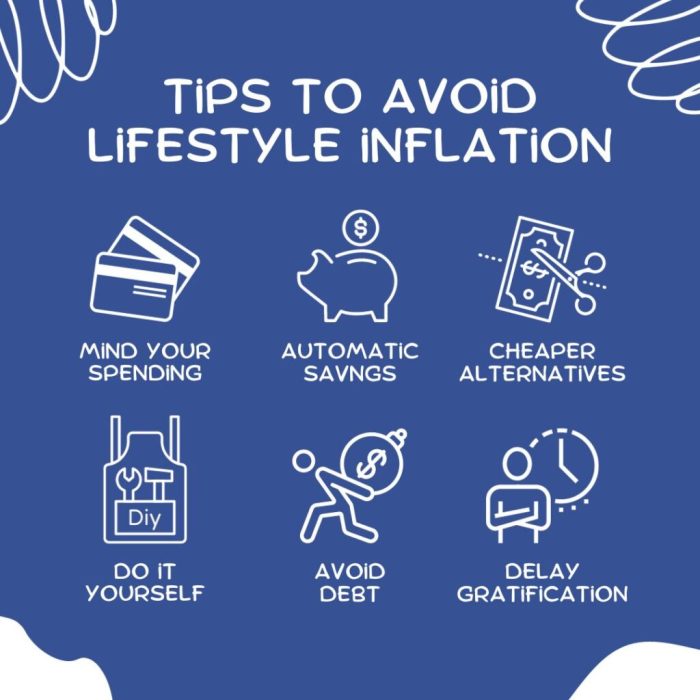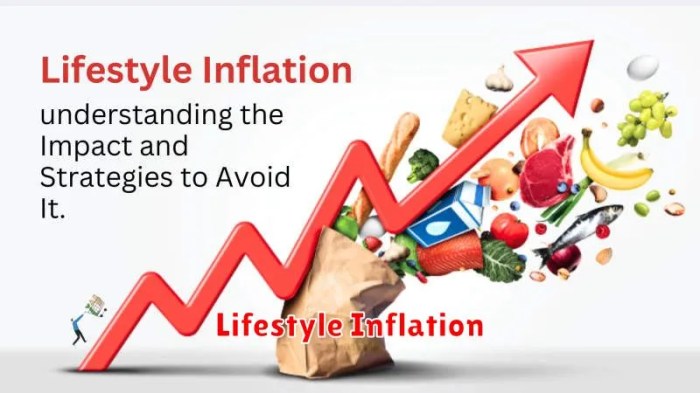Embark on a journey through the intricacies of lifestyle inflation and discover effective strategies to steer clear of its pitfalls. This introduction sets the stage for a compelling exploration of financial well-being and prudent decision-making.
Unravel the nuances of triggers, preventative measures, and long-term financial planning to navigate the maze of lifestyle inflation.
Understanding Lifestyle Inflation
Lifestyle inflation refers to the gradual increase in spending as an individual's income rises. This phenomenon can have a significant impact on one's financial well-being over time.
As income increases, individuals may start to upgrade their lifestyle by spending more on luxury items, dining out frequently, buying a bigger house, or purchasing expensive gadgets. These small changes in spending habits can add up over time, leading to a lifestyle that requires a higher income to sustain.
Examples of Lifestyle Inflation
- Upgrading from a modest apartment to a luxury condo after a salary increase.
- Switching from budget-friendly meals to dining out at fancy restaurants regularly.
- Trading in a used car for a brand new luxury vehicle after a promotion.
Impact of Lifestyle Inflation
Lifestyle inflation can be harmful in the long run as it can lead to financial instability and prevent individuals from achieving their long-term financial goals. It can also increase dependency on a high income, making it challenging to save for emergencies or retirement.
Identifying Triggers for Lifestyle Inflation

When it comes to lifestyle inflation, there are various triggers that can lead individuals to increase their spending habits unnecessarily. These triggers can range from salary increases to societal pressures and even the influence of advertising and social media.
Salary Increases
One common trigger for lifestyle inflation is a salary increase. When individuals start earning more money, they may feel the urge to upgrade their lifestyle by purchasing more expensive items or indulging in luxury experiences.
Peer Pressure
Peer pressure can also play a significant role in pushing individuals towards lifestyle inflation. Seeing friends or colleagues with expensive possessions or engaging in lavish activities can create a desire to keep up, leading to increased spending.
Societal Expectations
Societal expectations, such as the pressure to appear successful or affluent, can contribute to lifestyle inflation. People often feel the need to display their wealth through material possessions, even if it means stretching their budget beyond reasonable limits.
Advertising and Social Media Influence
Advertising and social media platforms constantly bombard us with images of the ideal lifestyle, promoting products and experiences that may not be necessary but are presented as must-haves. This constant exposure can influence individuals to aspire towards a lifestyle that is beyond their means, ultimately leading to lifestyle inflation.
Strategies to Avoid Lifestyle Inflation
Avoiding lifestyle inflation is crucial for maintaining financial stability and achieving long-term financial goals. By implementing practical strategies, individuals can prevent themselves from falling into the trap of constantly increasing expenses.
1. Budgeting and Setting Financial Goals
Budgeting is a fundamental tool in managing finances effectively. By creating a detailed budget that Artikels your income, expenses, and savings goals, you can track your spending and identify areas where you can cut back. Setting financial goals, such as saving for a specific purchase or building an emergency fund, can help you stay motivated and focused on your long-term financial objectives.
- Track your spending: Keep a record of all your expenses to identify patterns and areas where you can reduce unnecessary spending.
- Allocate funds wisely: Prioritize your spending by allocating money towards essential needs, savings, and debt repayment before indulging in discretionary expenses.
- Automate savings: Set up automatic transfers to your savings account to ensure that you consistently save a portion of your income before spending it.
2. Distinguishing Between Needs and Wants
One of the key factors in avoiding lifestyle inflation is understanding the difference between needs and wants. Needs are essential for survival and well-being, such as food, shelter, and healthcare, while wants are desires that are not crucial for daily living.
By prioritizing needs over wants, you can prevent unnecessary spending and focus on what truly matters.
- Practice mindful spending: Before making a purchase, ask yourself if it is a necessity or a luxury item. Consider the long-term impact of your spending decisions on your financial goals.
- Avoid impulse purchases: Take time to evaluate whether a purchase aligns with your priorities and budget before committing to buy it.
- Set spending limits: Establish boundaries for discretionary spending to prevent overspending on non-essential items.
Long-Term Financial Planning
Long-term financial planning plays a crucial role in combating lifestyle inflation by providing a strategic framework for managing finances over an extended period. It involves setting achievable financial goals, creating a budget, and establishing saving and investment strategies to secure future financial well-being.
Investing, Saving, and Building Wealth
- Investing in diversified portfolios: By diversifying investments across different asset classes, such as stocks, bonds, and real estate, individuals can mitigate risks and potentially earn higher returns to counteract the impact of lifestyle inflation.
- Saving for retirement: Setting aside a portion of income in retirement accounts like 401(k) or IRA can ensure a stable financial future and provide a source of income during retirement, reducing the temptation to increase spending unnecessarily.
- Building wealth through compounding: Consistently saving and investing money over time allows for the power of compounding to grow wealth exponentially, providing a financial cushion against lifestyle inflation pressures.
Benefits of Creating an Emergency Fund
Creating an emergency fund is essential to protect against unexpected financial setbacks and lifestyle inflation risks. This fund acts as a financial buffer in times of crisis, such as job loss, medical emergencies, or major repairs, preventing individuals from resorting to debt or depleting long-term savings.
Having an emergency fund also instills financial discipline and peace of mind, enabling individuals to navigate financial challenges with confidence and stability.
Closing Notes

In conclusion, by understanding the triggers, implementing preventive strategies, and focusing on long-term financial stability, individuals can fortify themselves against the allure of lifestyle inflation. Stay vigilant and empowered on your financial journey.
Frequently Asked Questions
How can I resist lifestyle inflation temptations?
To resist lifestyle inflation, practice mindful spending, differentiate between needs and wants, and regularly review your financial goals.
What role does budgeting play in avoiding lifestyle inflation?
Budgeting helps track expenses, prioritize financial goals, and maintain a balanced approach to spending, thus guarding against lifestyle inflation.
Is lifestyle inflation reversible once it sets in?
While challenging, lifestyle inflation can be reversed by reassessing spending habits, downsizing unnecessary expenses, and focusing on long-term financial objectives.


![5 Best Field Service Management Software [2025]](https://ae.goodstats.id/wp-content/uploads/2025/09/38877ff56f11b8e71045b45896b02652-350x250.jpg)





![5 Best Field Service Management Software [2025]](https://ae.goodstats.id/wp-content/uploads/2025/09/38877ff56f11b8e71045b45896b02652-75x75.jpg)



